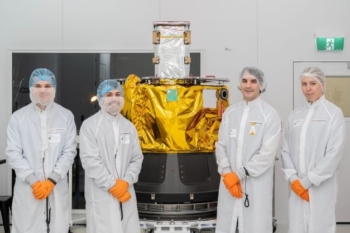The launch of NASA’s Cislunar Autonomous Positioning System Technology Operations and Navigation Experiment, or CAPSTONE, is no longer targeting a June 13 takeoff, but perhaps by month’s end.
Since arriving at its New Zealand departure point, CAPSTONE has been successfully fueled and integrated with the Lunar Photon upper stage by teams from Rocket Lab, Terran Orbital, and Stellar Exploration. CAPSTONE and Photon have been encapsulated in the payload fairing.
CAPSTONE is supporting NASA’s Artemis program as a pathfinder for NASA’s Gateway station, a Moon-orbiting outpost.
The mission is to help reduce the risk for future spacecraft by validating innovative navigation technologies and verifying the dynamics of the Near Rectilinear Halo Orbit (NRHO).
Staging area
As a 12U CubeSat, CAPSTONE’s orbit also establishes a location that is an ideal staging area for missions to the Moon and beyond. Its location at a precise balance point in the gravities of the Earth and the Moon offers stability for long-term missions like Gateway and requires minimal energy to maintain.
Designed and built by Terran Orbital, the CAPSTONE payload and its software are owned and operated by Advanced Space for NASA.
The smallsat is soon to be launched, perhaps by month’s end, atop a Rocket Lab Electron rocket from Rocket Lab Launch Complex 1 (LC-1) on the Mahia Peninsula of New Zealand. That company’s Lunar Photon satellite upper stage will send the spacecraft on its planned lunar transfer trajectory.
CAPSTONE will not go directly to the Moon. Instead, it will follow a “ballistic lunar transfer” that takes the craft out as far as 1.5 million kilometers before returning into lunar orbit. That transfer, which will take about four months to complete, is designed to save propellant, making the mission feasible for such a small spacecraft.
For more information on CAPSTONE, go to:





